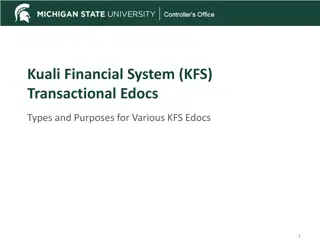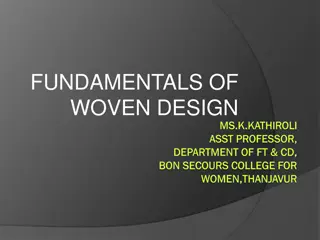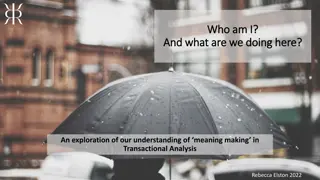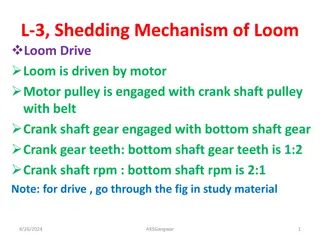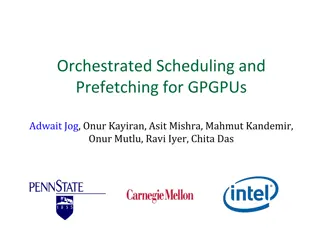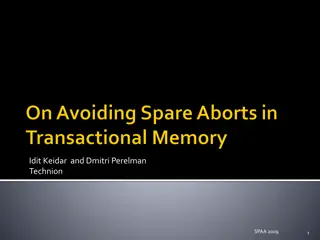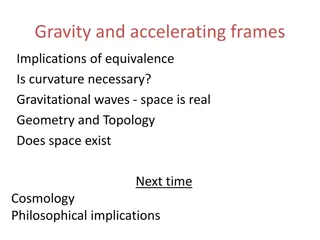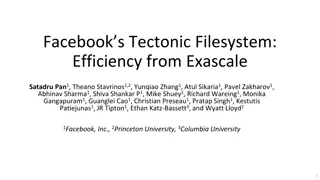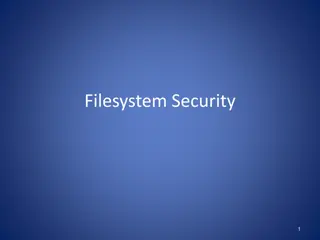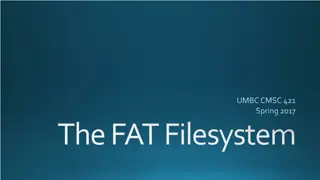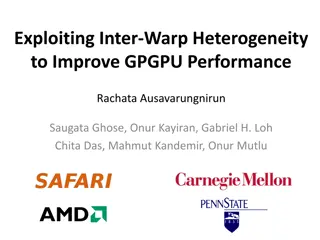The Design and Implementation of the Warp Transactional Filesystem
The Warp Transactional Filesystem (WTF) offers a new distributed filesystem design focusing on strong guarantees and zero-copy interfaces. It introduces the concept of file-slicing abstraction to enhance application performance, scalability, and transactional operations. The WTF architecture comprises components like Client Library, Metadata Storage, Storage Servers, and Replicated Coordinator. Zero-copy File Slicing APIs optimize data transfer processes, providing functionalities such as Yank, Paste, Append, and Concat, promoting concurrency and efficiency.
Download Presentation

Please find below an Image/Link to download the presentation.
The content on the website is provided AS IS for your information and personal use only. It may not be sold, licensed, or shared on other websites without obtaining consent from the author.If you encounter any issues during the download, it is possible that the publisher has removed the file from their server.
You are allowed to download the files provided on this website for personal or commercial use, subject to the condition that they are used lawfully. All files are the property of their respective owners.
The content on the website is provided AS IS for your information and personal use only. It may not be sold, licensed, or shared on other websites without obtaining consent from the author.
E N D
Presentation Transcript
The Design and Implementation of the Warp Transactional Filesystem Robert Escriva, Emin G n Sirer Computer Science Department, Cornell University Presented By Alex Garcia 1
Common Trends in Distributed Filesystems Compromises or limitations are often introduced in search of higher performance: Weak guarantees: (Google File System) Eventual consistency Narrow interfaces: (Hadoop Distributed File System) Writes must be sequential Concurrent writes prohibited Unscalable design: (FLAT Data Center Storage) Full-bisection bandwidth Large master server 2
Warp Transactional Filesystem (WTF) WTF represents a new design point in the space of distributed filesystems WTF employs the file-slicing abstraction to provide applications with strong guarantees and zero-copy filesystem interfaces Strong guarantees: transactionally access and modify the filesystem Expanded interface: traditional POSIX APIs and new zero-copy APIs Scalable Design: avoids centralized master or expensive network bottlenecks 3
WTF Architecture Client Library Contains the majority of the functionality of the system where it combines the Metadata and data into a coherent file system and provides transactional guarantees to the end user. Metadata Storage Provides transactional operations over metadata using HyperDex Warp. (No-SQL, Key-Value Store, Fault Tolerant and Strong Consistency, ACID Transactions) Storage Servers Hold the file system data and handle most of the I/O Replicated Coordinator Serves as a rendezvous point for all the components of the system and maintains a list of the storage servers. 4
Zero-Copy File Slicing APIs Traditional APIs transfer bytes back and forth through the filesystem interface File-slicing APIs deal in referencesto data already in the filesystem (No copying of file content needed) Yank: Obtain references to data in the filesystem Analogous to read Paste: Write referenced data back to the filesystem Analogous to write append Append: referenced data to the end of a file Optimized for concurrency Concat: Merge one or more files to create a new file Does not read or write data from the input files 5
File Slicing Abstraction The central abstraction is a slice: an immutable, byte-addressable, arbitrarily sized sequence of bytes A file is represented by a sequence of slices that, when overlaid, comprise the file s contents. Metadata is a sequence of slices. 6
Slices and Slice Pointers Slices pointers to slices reside in HyperDex. Slice pointers directly indicate a slice s location in the system Slices reside on storage servers Slice Pointer Tuple: Unique Identifier for the storage server holding the slice Local Filename containing the slice on that storage server File offset of the slice within the file Length of the slice Integer offset where the slice is to be overlaid. 7
Slices A Writer creates file slices on the storage servers. Overalys them at the appropriate positions within the file by appending their slice pointers to the metadata list. Readers retrieve the metadata list, compact it and determines which slice must be retrieved from the storage servers. The overlap, the latest takes precedence. 8
Locality-Aware Slice Placement Client library place slices contiguously to improve reads and metadata compaction. Consistent hashing across storage servers in the system on a per-file basis increases probability that sequentially written slices are adjacent The metadata for adjacent slices may be represented in a more compact form 9
Metadata Compaction and Defragmentation Compaction reduces the size of the metadata list by removing references to unused/overwritten portions of slices. Fragmented data is rewritten within the region into a single slice and replaces the metadata with a single pointer to the slice 10
Garbage Collection Garbage collection cleans up the slices no longer referenced by any slice pointer from the results of metadata compaction. WTF periodically scans the filesystem and constructs a list of in-use slice pointers for each storage server. Storage servers use the scan, along with their local data, to determine which data is garbage. 11
Fault Tolerance WTF uses replication to add fault tolerance to the system. Writers create multiple replicas slices on distinct servers and append their pointers atomically as one list entry. HyperDex uses value-dependent chaining to coordinate between the replicas and manage recovery from failures. 12
Applications & Evaluation MapReduce Sort:concat enables an efficient bucket-based merge sort Work Queue:append units of work are appended to the file; all contention happens in the metadata layer Video editor: yank and paste enable the editor to reorder scenes without rewriting the movie Fuse Bindings: transactional behavior exposed to the user for easy data exploration WTF can rewrite 377 GB of raw movie footage in 16 s using file slicing effectively 23 GB/s, as opposed to rewriting the footage using traditional APIs, which requires approximately three hours 13
Related Works Distributed Filesystems Farsite, AFS, xFS, Swift, Petal, Frangipani, NASD, Panasas Data Center Filesystems CalvinFS, GFS, HDFS, Salus, Flat Datacenter Storage, Blizzard, f4, Pelican Transactional Filesystems QuickSilver, Transactional LFS, Valor, PerDis FS, KBDBFS, Inversion, Amino 14
QUESTIONS ? 15
THANK YOU! 16


